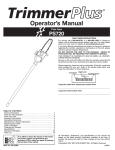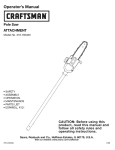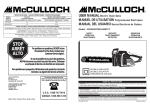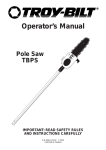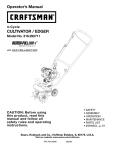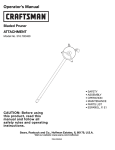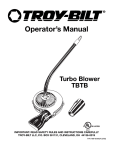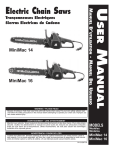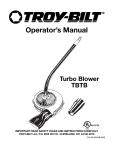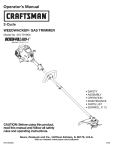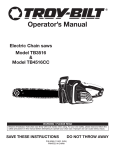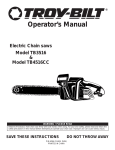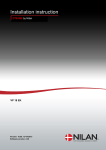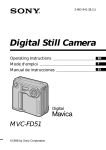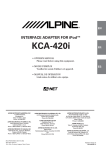Download 769-03569A 79246 Pole Saw LARGE:Layout 1
Transcript
Operator’s Manual ® Pole Saw ATTACHMENT Model No. 316.792460 • SAFETY • ASSEMBLY • OPERATION • MAINTENANCE • PARTS LIST • ESPAÑOL, P. E1 CAUTION: Before using this product, read this manual and follow all safety rules and operating instructions. Sears, Roebuck and Co., Hoffman Estates, IL 60179, U.S.A. Visit our website: www.sears.com/craftsman 769-03569A 3/08 RULES FOR SAFE OPERATION TABLE OF CONTENTS Rules for Safe Operation . . . . . . . . . . . . . . . . . . . . . . . . . . . . . . . . .2 Warranty . . . . . . . . . . . . . . . . . . . . . . . . . . . . . . . . . . . . . . . . . . . . .4 Know Your Unit . . . . . . . . . . . . . . . . . . . . . . . . . . . . . . . . . . . . . . . .5 Assembly Instructions . . . . . . . . . . . . . . . . . . . . . . . . . . . . . . . . . . .5 Operating Instructions . . . . . . . . . . . . . . . . . . . . . . . . . . . . . . . . . . .6 Maintenance & Repair Instructions . . . . . . . . . . . . . . . . . . . . . . . . .7 Replacing Saw Chain . . . . . . . . . . . . . . . . . . . . . . . . . . . . . . . . . . .7 Chain Lubrication . . . . . . . . . . . . . . . . . . . . . . . . . . . . . . . . . . . . . .8 Cleaning and Storage . . . . . . . . . . . . . . . . . . . . . . . . . . . . . . . . . . .8 Specifications . . . . . . . . . . . . . . . . . . . . . . . . . . . . . . . . . . . . . . . . .8 Parts List . . . . . . . . . . . . . . . . . . . . . . . . . . . . . . . . . . . . . . . . . . .E11 Service Numbers . . . . . . . . . . . . . . . . . . . . . . . . . . . . . .Back Cover The purpose of safety symbols is to attract your attention to possible dangers. The safety symbols, and their explanations, deserve your careful attention and understanding. The safety warnings do not by themselves eliminate any danger. The instructions or warnings they give are not substitutes for proper accident prevention measures. SYMBOL SAFETY ALERT: Indicates danger, warning or caution. Attention is required in order to avoid serious personal injury. May be used in conjunction with other symbols or pictographs. NOTE: Advises you of information or instructions vital to the operation or maintenance of the equipment. Before beginning, locate the unit’s model plate. It lists the model and serial numbers of your unit. Refer to the sample plate below and copy the information for future reference. DANGER: Failure to obey a safety warning will result in serious injury to yourself or to others. Always follow the safety precautions to reduce the risk of fire, electric shock and personal injury. WARNING: Failure to obey a safety warning can result in injury to yourself and others. Always follow the safety precautions to reduce the risk of fire, electric shock and personal injury. MODEL : S/N : MEANING ITEM : CAUTION: Failure to obey a safety warning may result in property damage or personal injury to yourself or to others. Always follow the safety precautions to reduce the risk of fire, electric shock and personal injury. Copy the model and parent part number here: All information, illustrations, and specifications in this manual are based on the latest product information available at the time of printing. We reserve the right to make changes at any time without notice. Copy the serial number here: Read the Operator’s Manual and follow all warnings and safety instructions. Failure to do so can result in serious injury to the operator and/or bystanders. FOR QUESTIONS, CALL 1–800–659–5917 • IMPORTANT SAFETY INSTRUCTIONS • KICKBACK SAFETY PRECAUTIONS READ ALL INSTRUCTIONS BEFORE OPERATING WARNING: Kickback may occur when the nose or tip of the WARNING: When using the unit, you must follow the safety rules. Please read these instructions before operating the unit in order to ensure the safety of the operator and any bystanders. Please keep these instructions for later use. guide bar touches an object, or when the wood closes in and pinches the saw chain in the cut. Tip contact in some cases may cause a lightning-fast reverse action, kicking the guide bar rapidly back towards the operator. Pinching the saw chain along the top of the guide bar may push the guide bar rapidly back towards the operator. Either of these reactions may cause you to lose control of the saw, which could result in serious injury to the user. Do not rely exclusively upon the safety devices built into your saw. As a pole saw user, you should take several steps to keep your cutting jobs free from accident or injury. • With a basic understanding of kickback, you can reduce or eliminate the element of surprise. Sudden surprise contributes to accidents. • Grip trimmer firmly. Hold the pole saw/ trimmer unit firmly with both hands when the motor is running. Keep one hand on the grip and the other hand on the handle. • Do not let the nose of the guide bar contact a log, branch, ground or other obstruction. • Always cut with the engine running at full speed. Fully squeeze the throttle trigger and maintain a steady cutting speed. • Do not over reach. • Follow the manufacturer’s sharpening and maintenance instructions for the saw chain. • Use only replacement bars and chains specified by the manufacturer or the equivalent. SAFETY WARNINGS FOR ELECTRIC POWERHEADS • Carefully read and understand the operator's manual of the unit that powers this attachment. • Read this operating instruction manual carefully. Be thoroughly familiar with the controls and the proper use of the equipment. Know how to stop the unit and disengage the controls quickly. • Do not operate this unit when tired, ill, or under the influence of alcohol, drugs, or medication. • Never allow children to operate the equipment. Never allow adults unfamiliar with the instructions to use the unit. Never allow adults to operate the equipment without proper instruction. • All guards and safety attachments must be installed properly before operating the unit. POLE SAW OPERATING PROCEDURES • Keep bystanders, especially children and pets, at least 50 ft (15 m) away. • Wear safety glasses or goggles that are marked as meeting ANSI Z87.1–1989 standards, and ear/hearing protection when operating this unit. Wear a face or dust mask if the operation is dusty. • Wear heavy, long pants, boots, gloves and a long sleeve shirt. Do not wear loose clothing, jewelry, short pants, sandals or go barefoot. Secure hair above shoulder level. • Use the unit only in daylight or good artificial light. • Use the right tool. Only use this tool for the purpose intended. • Always stop the engine when operation is delayed or when walking from one location to another. • Use only OEM replacement parts and accessories for this unit. These are available from your authorized service dealer. Use of any unauthorized parts or accessories could lead to serious injury to the user or damage to the unit, and void your warranty. WARNING: To reduce the risk of electrical shock, use only extension cords approved for outdoor use, such as an extension cord of cord type SW-A, SOW-A, STW-A, STOWA, SJW-A, SJOW-A, SJTW-W or SJTOW-A. Extension cords are available from your local retailer. Use only roundjacketed extension cords approved for outdoor use. 2 RULES FOR SAFE OPERATION • Do not expose the pole saw to rain. Do not use the pole saw in damp or wet locations. • Do not use the pole saw in the presence of flammable liquids or gases. • All pole saw service, other than the items listed in the operator’s manual safety and maintenance instructions, should be performed by competent pole saw personnel. Do not attempt to repair it yourself; there are no user serviceable parts inside. • The pole saw will do a better and safer job when used at the rate for which it was intended. • Use the right tool. Cut wood only. Do not use the pole saw for purposes for which it was not intended. For example, do not use the pole saw for cutting plastic, masonry, or non-building materials. • Use devices, such as low-kickback chain, guide bar nose guards, chain brakes and special guide bars, which reduce the risks associated with kickback. • There are no other replacement components for achieving kickback protection in accordance with CSA Z62.3. • Do not operate a pole saw that is damaged, improperly adjusted, or not completely and securely assembled. Be sure that the saw chain stops moving when the trigger is released. • Do not attempt operations beyond your capacity or experience. • Never remove, modify or make inoperative any safety device furnished with your unit. • This saw is intended for infrequent use by homeowner’s, cottagers and campers, and for such general applications such as clearing and pruning. It is not intended for prolonged use. If the intended use involves prolonged periods of operation, this may cause circulatory problems in the user’s hands due to vibration. It may be appropriate to use a saw having an anti-vibration feature. • Safety clothing required by your safety organizations, government regulations, or your employer should be used; otherwise, snug fitting clothing, safety footwear, and hand and ear protection should be worn. • Low-kickback saw chain is chain that has met the kickback performance requirements of ANSI B175.1-1991 and is in accordance with CSA Z62.3. Do not use other replacement chain unless it has met these requirements for your specific model. • Do not use any other cutting attachment or accessories. Use only original equipment manufacturer replacement parts and accessories, which are designed specifically to enhance the performance and maximize the safe operation of our products. Failure to do so may cause poor performance and possible injury. Use only the chain and bar supplied with this product. Do not use any other cutting attachment. Use of such attachments will void your factory warranty and could result in serious bodily injury. • Never touch the chain or attempt to service the saw while the engine is running. Make sure all moving parts have stopped. Allow the chain to cool, as the chain can be hot. • Check the bar and chain at frequent intervals for proper adjustment. Make sure the bar and chain are properly tightened and sharpened. Visually inspect for damage. Repair any damage before restarting or operating the pole saw. • Do not cut near electrical cables or power lines. • Do not use the pole saw to fell a tree. Use a standard chain saw for this application. MAINTENANCE AND STORAGE • Allow the unit to cool before storing or transporting. Be sure to secure the unit while transporting. • Always use the transport guard on the bar and chain during transportation and storage. • Store the unit in a locked up and dry or high and dry place to prevent unauthorized use or damage, out of the reach of children. • Never douse or squirt the unit with water or any other liquid. Keep handles dry, clean and free from debris. Clean after each use. • Keep these instructions. Refer to them often and use them to instruct other users. If you loan someone this unit, also loan them these instructions. • Only qualified personnel should perform any repairs or maintenance procedures that are not described in this manual. • CORD SETS: Make sure your cord set is in good condition. When using a cord set, be sure to use a cord that is heavy enough to carry the current that your unit will draw. An undersized cord set will cause a drop in line voltage resulting in loss of power and overheating. See the operator’s manual for the unit that will power this attachment for the recommended cord size. • Inspect all extension cords and the unit power connection periodically. Look closely for deterioration, cuts or cracks in the insulation. Also inspect the connections for damage. Replace the cords if any defects or damage appear. • Prevent disconnection of the electric powerhead from extension cord during operation by using a plug-receptacle retaining strap, connector, or by making a knot as shown below: Extension Cord Powerhead Cord Extension Cord Powerhead Cord DANGER: RISK OF CUT OR SHOCK — Keep hands away from blades. Keep one hand on assist handle on the powerhead and on the loop handle of attachment when power is on. Do not attempt to remove cut material or hold material to be cut when blades are moving. Make sure the switch on the power unit is off when clearing jammed material from blades. Do not grasp the exposed cutting blades or cutting edges of the pole saw. Wear gloves when handling the blade. Do not operate unit with one hand. • Avoid dangerous environments. Never operate your unit in damp or wet conditions. Moisture is a shock hazard. • Do not use the unit in the rain. Do not use in or around water. Do not use on wet hedges or shrubbery. • Do not handle the plug or unit with wet hands or standing on any wet surfaces. • Do not leave the unit plugged in when not in use, changing attachments or add-ons, or while being serviced. OTHER SAFETY PRECAUTIONS • DO NOT operate a pole saw with one hand! Serious injury to the operator, helpers, or bystanders may result from one-handed operation. A pole saw is intended for two-handed use. • Do not operate a pole saw if you are fatigued. • Do not wear loose clothing or jewelry, as they can get caught in moving parts. Non-skid footwear is recommended when working outdoors. Wear protective hair covering to contain long hair. • Use safety glasses, safety footwear, snug fitting clothing, protective gloves, and protective hearing and head gear. • Keep the work area clean. Cluttered areas invite injuries. Do not start cutting until you have a clear work area, secure footing, and a planned retreat path from the falling branches. • Stay Alert. Watch what you are doing. Use common sense. Do not operate the pole saw when you are tired. Keep all parts of your body away from the saw chain when the motor is operating. Before you start the saw, make sure the saw chain is not contacting anything. • Disconnect the pole saw when not in use, before servicing, and when changing accessories and attachments such as saw chain and guard. • Check damaged parts. Before further use of the pole saw, a guard or other part that is damaged should be carefully checked to determine that it will operate properly and perform its intended function. Check for alignment of moving parts, binding of moving parts, breakage of parts, mounting, and any other conditions that may affect its operation. A guard or other part that is damaged should be properly repaired or replaced by an authorized service center, unless otherwise indicated in this instruction manual. • Use extreme caution when cutting small sized brush and sapling, as slender material may catch the saw chain and be whipped toward you or pull you off balance. • Do not operate a pole saw in a tree unless you are specifically trained to do so. When cutting a limb that is under tension, be alert for spring back so that you will not be struck when the tension in the wood fibers is released. SAVE THESE INSTRUCTIONS 3 RULES FOR SAFE OPERATION This operator's manual describes safety and international symbols and pictographs that may appear on this product. Read the operator's manual for complete safety, assembly, operating and maintenance and repair information. SYMBOL MEANING SYMBOL • SAFETY ALERT SYMBOL Indicates danger, warning or caution. May be used in conjunction with other symbols or pictographs. MEANING • GUIDE BAR WARNING: Contact of the guide bar tip with any object should be avoided. Tip contact may cause the guide bar to move suddenly upward and backward, which may cause serious injury. • READ OPERATOR'S MANUAL WARNING: Read the operator’s manual(s) and follow all warnings and safety instructions. Failure to do so can result in serious injury to the operator and/or bystanders. • USE BOTH HANDS Always use both hands while operating the chain saw. Never use only one hand to operate the saw. • WEAR HEAD, EYE AND HEARING PROTECTION WARNING: Thrown objects and loud noise can cause severe eye injury and hearing loss. Wear eye protection meeting ANSI Z87.1-1989 standards and ear protection when operating this unit. Falling objects can cause severe head injury. Wear head protection when operating this unit.Use a full face shield when needed. • HOT SURFACE WARNING: Do not touch a hot surface. You may get burned. These parts get extremely hot from operation. They remain hot for a short time after the unit is turned off. • KEEP BYSTANDERS AWAY WARNING: Keep all bystanders, especially children and pets, at least 50 feet (15 m) from the operating area. • POWER LINES CAN CAUSE SEVERE INJURY WARNING: Do not operate unit near power lines. Contact with a power line may cause serious injury or damage to the unit. Maintain a clearance of at least 50 ft (15 m) between the pole saw (including any branches it is contacting) and any electrical line. • CHAIN OIL ADJUSTMENT INDICATOR The chain must be continously coated with oil to function properly. Make sure to set the Oil Adjustment Screw to allow a sufficient amount of oil to flow continuously onto the chain. Use a 3/32-inch Allen wrench to adjust the Oil Adjustment Screw. WARRANTY STATEMENT CRAFTSMAN FULL WARRANTY If this Craftsman product fails due to a defect in material or workmanship within one year from the date of purchase, return it to any Sears store or other Craftsman outlet in the United States for free replacement. This warranty applies for only 90 days if this product is ever used for commercial or rental purposes. This warranty covers ONLY defects in materal and workmanship. Sears will NOT pay for: • The chain saw bar and chain, wich are expendable items that can wear out from normal use within the warranty period. • Repairs necessary because of accident or failure to operate or maintain the product according to all supplied instructions. This warranty gives you specific legal rights, and you may also have other rights which vary from state to state. Sears, Roebuck and Co., Hoffman Estates, IL 60179 4 KNOW YOUR UNIT ASSEMBLY INSTRUCTIONS Removing the Attachment or Extension Boom Chain Transport Guard Guide Bar Guide Bar Nose WARNING: To avoid serious personal injury and damage to the unit, shut the unit off before removing or installing add-ons. 1. Turn the knob Release Button Convertible™ counterclockwise to Coupler loosen (Fig. 3). 2. Press and hold the release button (Fig. 1). 3. While firmly holding the upper shaft housing, pull the attachment or Knob extension boom out of the Guide Recess coupler (Fig. 2). Fig. 1 Installing the Attachment or Extension Boom Saw Chain Bar Retaining Nuts Hook Oil Tank Cap Chain Guard Drive Shaft WARNING: To avoid serious personal injury and damage to the unit, NEVER install more than one extension boom to a power tool. Craftsman Convertible™ Coupler Primary Hole 1. Remove the hanger or shipping cap from the top of the shaft housing. 2. Turn knob counterclockwise to loosen (Fig. 3). 3. While firmly holding the Upper Shaft attachment, push it Lower Shaft Housing straight into the Housing Convertible™ coupler Fig. 2 until the release button snaps firmly into the primary hole (Fig. 6). NOTE: Aligning the release button with the guide recess will help installation (Fig. 1). 4. Turn the knob clockwise to tighten (Fig. 3). Knob 5. Repeat steps 1–4 for the Fig. 3 attachment or extension boom. The attachment should be installed with the release button in the primary hole. Extension Boom Oil Adjustment Screw Shipping Cap Hanger Tension Adjustment Screw Oil Reservoir ASSEMBLY INSTRUCTIONS FILLING THE OIL RESERVOIR DANGER: Failure to fill the oil reservoir will cause irreparable damage to the unit. Make sure the oil reservoir is always filled. Follow the following steps to fill the oil reservoir: 1. Place the unit on a flat surface. 2. Remove the Oil Tank Cap. 3. Open the bar & chain oil bottle provided with your unit. 4. Pour oil into the reservoir until filled. NOTE: The oil reservoir may be filled to the lip of the fill opening without damaging the unit. CAUTION: Lock the release button in the primary hole and securely tighten the knob before operating this unit. CAUTION: Add-ons are to be used in the primary hole only. Using the wrong hole could lead to personal injury or damage to the unit. WARNING: Oil constantly flows from the oil reservoir to oil the chain. Check the oil level constantly so that the oil level does not drop below half full. Check Flex Shaft Engagement Prior to Using 1. Start the unit. 2. Briefly engage and release the trigger. 3. Check that attachment is operating. 4. If the attachment is not operating, remove attachment and repeat steps for installing the attachment. 5. Recheck operation of the attachment. INSTALLING/ REMOVING ATTACHMENT WARNING: Prior to operation, read and understand the operator’s manual for unit to be used with this attachment. The attachment may be mounted to different power tools. The instruction manuals for the basic power tool and the attachment contain the information necessary for operation of the power tool combination. Therefore, aways read BOTH instruction manuals before using the power tool for the first time. Keep the manuals in a safe place for future reference. NOTE: To make installing or removing the attachment easier, place the unit on the ground or on a work bench. 5 OPERATING INSTRUCTIONS 1. Place the pole saw on firm ground or other solid surface in an open area. 2. Maintain good balance and secure footing. OPERATING TIPS OPERATING PRECAUTIONS WARNING: Dress properly to reduce the risk of injury when operating this unit. Do not wear loose clothing or jewelry. Wear eye and ear/hearing protection. Wear heavy long pants, boots and gloves. Wear a hard hat. Use a full face shield when needed. WARNING: Kickback may occur when the nose or tip of the guide bar touches an object, or when the wood closes in and pinches the saw chain in the cut. Tip contact in some cases may cause a lightning-fast reverse action, kicking the guide bar rapidly back towards the operator. Pinching the saw chain along the top of the guide bar may push the guide bar rapidly back towards the operator. Either of these reactions may cause you to lose control of the saw, which could result in serious injury to the user. Do not rely exclusively upon the safety devices built into your saw. As a chain saw user, you should take several steps to keep your cutting jobs free from accident or injury. 1. Keep bystanders 50 feet (15 meters) away when operating the saw. 2. Do not use the pole saw to cut down trees. Use a chain saw without a pole attachment. 3. Make sure the oil tank is full and oil is lubricating the chain prior to starting. 4. Grip pole saw/ trimmer securely—one hand on the grip, the other on the handle. Fig. 4 5. Keep finger off the trigger until ready to make cut. 6. Before starting the pole saw, make sure the chain is not touching anything. 7. Keep all parts of your body away from the chain when the saw is running. 8. Do not force the chain saw while cutting. Apply light Fig. 5 pressure. It will do the job better and safer at the rate for which it was intended. 9. When cutting limbs or branches that are under tension, use extreme caution. Be alert for wood springing back. When wood tension is released, the limb could spring back and strike operator causing severe injury or death. Fig. 6 10. When carrying pole saw from one place to another: • hold pole at balance point • keep guide bar and chain to the rear 11. Do not cut small brush and saplings with the pole saw. Slender matter may catch in the chain and be whipped toward you. This could also pull you off balance. 12. Never stand directly under the limb you are trimming. Always position yourself out of the path of falling debris (Fig. 4). 13. Never stand on a ladder or other type of unstable support while using the pole saw. 14. Always use both hands to operate pole saw. Keep a firm, steady pressure on the pole saw while cutting, but do not try to force the saw through the wood. • Avoid kickback. Kickback can result in severe injury or death. • Do not operate the pole saw while in a tree, on a ladder or any other unstable work surface, or in any awkward position. You may lose control of the pole saw causing severe injury. • Do not extend your arms above shoulders when using the pole saw. • Seek professional help if you are facing conditions beyond your ability. • Trimming a tree is the process of cutting limbs from a living tree. Make sure your footing is firm. Keep your feet apart. Divide your weight evenly on both feet. • Before starting unit, always check the chain lubrication and oil tank level. NOTE: The chain must be continously coated with oil to function properly. Make sure that the oil adjustment screw is set appropriately. To trim a limb (pruning): WARNING: If the oil tank runs out, the oil ajustment screw hole becomes clogged, or the chain fails to get proper lubrication in any fashion, the chain will overheat and cause irreversible damage to the unit and may result in severe injury. Excessive heat from friction can lead the chain to catastrophically fail and come off the bar while operating. 1. Make the first cut six inches from tree trunk on the underside of the limb. Use the top of the guide bar to make this cut. Cut a third of the way through Cut 2 Cut 4 6in (15.2cm) the diameter of the limb (Fig. 7). 2. Move two to four inches farther out on the limb. 2-4in (5.1-10.2 cm) Make the second cut from above the limb. Continue Cut 1 Cut 3 the cut until you cut the limb off. 3. Make the third cut as close Fig. 7 to the tree trunk as possible on underside of limb stub. Use the top of the guide bar to make this cut. Cut a third through the diameter of stub. 4. Make the fourth cut directly above the third cut. Cut down to meet the third cut. This will remove the limb stub. WARNING: Do not use the pole saw to cut limbs larger than 4” (10 cm) in diameter. 15. Keep other persons away from cutting end of pole saw and at a safe distance from work area. (Fig. 5). 16. Do not use the pole saw near cable, electric power or telephone lines. Maintain a minimum clearance of 50 feet (15 m) from all power lines (Fig. 6). STARTING INSTRUCTIONS WARNING: To reduce the risk of fire and burn injuries, start the engine at least 30 ft. (9.1 m) from the fueling spot, outdoors only. Start and operate your pole saw without assistance. For specific starting instructions, see the appropriate section of your powerhead manual. Proper starting methods reduce the risk of injury. 6 MAINTENANCE AND REPAIR INSTRUCTIONS 4. Holding the nose in upper position, securely tighten the bar retaining nuts. CHAIN LUBRICATION The pole saw chain is self-lubricating. Oil is dispersed onto the chain as the unit is used. Keep an adequate amount of oil in the oil tank. Use the bar-chain oil provided in the hardware pack. Always use bar-chain and sprocket oil Oil Adjustment Screw or similar chain saw oil. Setting the Oil Adjustment Screw The Oil Adjustment Screw is located on top of the gearbox assembly (Fig. 12). 1. Insert a 3/32-inch Allen Gearbox Assembly wrench into the oil adjustment screw. Fig. 12 2. Turn the screw counterclockwise to increase oil flow to the chain. 3. Turn the screw clockwise to restrict the oil flow to the chain. SAW CHAIN REPLACEMENT/INSTALLATION WARNING: Whenever handling the saw chain, always wear work gloves for protection against sharp cutting edges. The pole saw chain and bar are expendable items, not covered by the product warranty. Replacement chain or bar is available for purchase through Sears parts and repair. Chain Guard 1. Remove the bar retaining B nuts and screw. Then take off A the chain guard (Fig. 8, B). 2. Using a flat-head screwdriver turn tension adjustment screw counterclockwise (Fig. 8, A) 4 turns. Screw Tension 3. Take off the chain and bar. Adjustment Screw Bar Retaining Nuts 4. Prepare new chain and/or Fig. 8 bar, and fit the chain into the groove in the bar. 5. Loop the saw chain over the drive sprocket with the cutting edges of the chain pointing in the direction of rotation (Fig. 9). 6. Adjust the tension adjustment screw (Fig. 8, A) to allow insertion of the bar (Fig. 10). Make sure Fig. 9 the chain follows the slot in the guide bar and adjust the tension adjustment screw to make the chain fit snugly on the underside of the bar. 7. Install the chain guard and tighten bar retaining nuts Slot and screw (Fig. 8, B). SAW CHAIN TENSION Fig. 10 ADJUSTMENT WARNING: If the oil tank runs out, the oil ajustment screw hole becomes clogged, or the chain fails to get proper lubrication in any fashion, the chain will overheat and cause irreversible damage to the unit and may result in severe injury. Excessive heat from friction can lead the chain to catastrophically fail and come off the bar while operating. GUIDE BAR MAINTENANCE WARNING: Ensure that the unit is off and the spark plug is disconnected (gas powerheads) before performing any maintenance on your saw. NOTE: Proper maintenance of the guide bar is essential to the performance of your pole saw. Proper guide bar maintenance will keep your saw in good working order. Most guide bar problems can be prevented merely by keeping the chain saw well maintained. Incorrect filing and non-uniform cutter and depth gauge settings cause most guide bar problems, primarily resulting in uneven bar wear. As the bar wears unevenly, the rails widen, which may cause chain clatter and difficulty in making straight cuts. Insufficient guide bar lubrication and operating the saw with a chain that is too tight will contribute to rapid bar wear. Refer to Saw Chain Tension Adjustment and Oiling the Chain. To help minimize bar wear, the following guide bar maintenance is recommended: Bar Wear Turn guide bar frequently at regular intervals (for example, after 5 hours of use), to ensure even wear on top and bottom of bar. Bar Grooves Bar grooves (or rails which support and carry the chain) should be cleaned if the saw has been heavily used or if the saw chain appears dirty. Rails should always be cleaned Fig. 13 every time the saw chain is removed. To clean guide bar rails: 1. Remove chain guard, bar, and chain. Refer to Saw Chain Replacement / Installation. 2. Using a screwdriver, putty knife, wire brush or other similar instrument, clear residue from the rails on the guide bar (Fig. 13). This will keep the oil passages open to provide proper lubrication to the bar and chain. 3. Ensure the sprocket in the bar turns freely during cleaning. NOTE: Oil passages at the bar pad should be cleaned to ensure proper lubrication of the bar and chain during operation. This should be done while the bar is removed for cleaning. CAUTION: If a chain is too loose or too tight, the bar chain and saw bearings will wear more rapidly. Refer to Figure 11 for information concerning correct cold tension (A), correct warm tension (B), and a chain in need of adjustment (C). Proper tension of the saw chain is extremely important and must be checked before starting, as well as during, any cutting operation. Taking the time to make needed adjustments to the saw chain will result in improved cutting performance and prolonged chain life. NOTE: A new chain and bar will need readjustment after as few as 5 cuts. This is normal during the break-in period, and the interval between future adjustments A C B will lengthen quickly (Fig. 11). Fig. 11 To adjust the saw chain tension: 1. Loosen the bar retaining nuts so they are hand tight (Fig. 8, B). 2. Holding the nose of the bar up, use the screwdriver to turn the guide bar adjustment screw clockwise to tighten the chain (Fig. 8, A). Turning the screw counterclockwise loosens the chain on the guide bar. 3. While wearing heavy duty work gloves (after you’ve made the adjustment), move the saw chain back and forth on the guide bar to be sure the chain moves freely and is in proper mesh with the sprocket. Never move the chain with your bare hands. NOTE: If the chain is difficult to rotate or if it binds on the guide bar, there is too much tension applied and it must be adjusted. To decrease tension, turn the adjustment screw counterclockwise, slowly. Move the chain back and forth until it moves freely. 7 MAINTENANCE AND REPAIR INSTRUCTIONS On the bar pad use a soft wire small enough to insert into the oil discharge hole, scrape any saw dust or debri away. (Fig. 14) 5. Reinstall the bar, chain, chainguard, screw, and bar retaining nuts. Refer to Saw Chain Replacement / Installation. CHAIN MAINTENANCE MAINTENANCE AND REPAIR INSTRUCTIONS Breaking in a New Saw Chain A new chain and bar will need readjustment after as few as 5 cuts. This is normal during the break-in period, and the interval between future adjustments will begin to lengthen quickly. Over a period of time, however, the moving parts of the saw chain will become worn, resulting in what is called chain stretch. This is normal. When it is no longer possible to obtain correct chain tension adjustment, it is recommended to purchase a replacement chain at Sears or other qualified service dealer have this repair performed. CLEANING 4. Fig. 14 WARNING: Never use a loop of chain that has more than 3 links removed from it. This could damage the sprocket. WARNING: Unless you have experience and specialized • Slacken the chain if you have retensioned it at operating temperature during cutting work. • The chain contracts as it cools down. If it is not slackened, it may damage the gearbox and bearings. STORAGE Wait for the engine to cool down. Drain the oil tank and store the machine in a dry place well away from sources of ignition until you need it again. • Attach the transport guard to the bar/chain before storing the unit. • Store the unit in a dry, high and/or locked location, out of the reach of children and other unauthorized persons. LONG-TERM STORAGE • Remove the saw chain and guide bar, clean them, and spray them with corrosion inhibiting oil. • Attach the transport guard to the bar/chain before storing. training for dealing with kickback (see Important Safety Instructions), always use a low-kickback saw chain, which significantly reduces the danger of kickback. Low-kickback saw chain does not completely eliminate kickback. A low-kickback or “safety chain,” should never be regarded as total protection against injury. Always use a replacement saw chain designed as “low-kickback” or a saw chain which meets the low-kickback performance. A standard saw chain (a chain which does not have the kickback reducing guard links) should only be used by an experienced professional chain saw operator. Low-Kickback Saw Chain WARNING: Never remove, modify or make inoperative any safety device furnished with your unit. The low-kickback saw chain is a major safety feature provided for your protection. WARNING: Ensure that the unit is off and the spark plug is disconnected (for gas powerheads) when working on the saw chain. Wear heavy duty gloves too. SPECIFICATIONS A low-kickback saw chain is a chain which has met the kickback performance requirements of ANSI B175.1. Do not use other replacement chain unless it has met these requirements for your specific model. By keeping the saw chain in good working condition and correctly serviced as recommended in this manual, you will be able to maintain the safety system of your pole saw over the life of the product. Chain Tension Check the chain tension frequently and adjust as often as necessary to keep the chain snug on the bar, but loose enough to be pulled around by hand. Refer to Saw Chain Tension Adjustment. POLE SAW ATTACHMENT Approximate Operating Weight of Attachment. . . . . 3.3 lbs. (1.5 kg) Drive Shaft Length . . . . . . . . . . . . . . . . . . . . . . . . 26 inches (66 cm) Cutting Length . . . . . . . . . . . . . . . . . . . . . . . . . . . 8 inches (20.3 cm) * All specifications are based on the latest product information available at the time of printing. We reserve the right to make changes at any time without notice. NEED MORE HELP? You’ll find the answer and more on managemyhome.com – for free! I I I I Find this and all your other product manuals online. Get answers from our team of home experts. Get a personalized maintenance plan for your home. Find information and tools to help with home projects. brought to you by Sears 8 Manual del Operador ® Accesorio de CORTADORA DE POSTE Modélo No. 316.792460 • SEGURIDAD • MONTAJE • FUNCIONAMIENTO • MANTENIMIENTO • LISTADO DE PIEZAS PRECAUCION: Lea el manual del operador y siga todas las advertencias e instrucciones de seguridad. Sears, Roebuck and Co., Hoffman Estates, IL 60179, U.S.A. Visite nuestro sitio web: www.sears.com/craftsman 769-03569A 3/08 NORMAS PARA UNA OPERACIÓN SEGURA TINDICE DE CONTENIDOS Normas para una operación segura . . . . . . . . . . . . . . . . . . . . . . .E2 Garantía . . . . . . . . . . . . . . . . . . . . . . . . . . . . . . . . . . . . . . . . . . . . .E4 Conozca su unidad . . . . . . . . . . . . . . . . . . . . . . . . . . . . . . . . . . . .E5 Instrucciones de montaje . . . . . . . . . . . . . . . . . . . . . . . . . . . . . . .E5 Instrucciones de operación . . . . . . . . . . . . . . . . . . . . . . . . . . . . . .E6 Instrucciones de mantenimiento . . . . . . . . . . . . . . . . . . . . . . . . . .E7 Cadena instalación de remplazo . . . . . . . . . . . . . . . . . . . . . . . . . .E7 Lubricación de la cadena . . . . . . . . . . . . . . . . . . . . . . . . . . . . . . .E8 Limpieza y almacenamiento . . . . . . . . . . . . . . . . . . . . . . . . . . . . .E8 Especificaciones . . . . . . . . . . . . . . . . . . . . . . . . . . . . . . . . . . . . . .E8 Lista de piezas . . . . . . . . . . . . . . . . . . . . . . . . . . . . . . . . . . . . . .E11 Servicio Numera . . . . . . . . . . . . . . . . . . . . . . . . . . . .Contraportada Antes de que empiece a ensamblar su nuevo equipo, por favor ubique la placa que contiene el modelo de la unidad y escriba esa información en el espacio en blanco aquí debajo. Aquí debajo se explica la muestra de una placa del modelo. Los símbolos de seguridad se utilizan para llamar su atención sobre posibles peligros. Los símbolos de seguridad y sus explicaciones merecen toda su atención y comprensión. Los símbolos de seguridad no eliminan ningún peligro por sí mismos. Las instrucciones o advertencias que ofrecen no substituyen las medidas adecuadas de prevención de accidentes. SIMBOLO SIGNIFICADO ALERTA DE SEGURIDAD: Indica peligro, advertencia o precaución. Debe prestar atención para evitar sufrir graves lesiones personales. Puede ser utilizado junto con otros símbolos o figuras. NOTA: Le ofrece información o instrucciones que son esenciales para la operación o mantenimiento del equipo. PELIGRO: El no obedecer una advertencia de seguridad puede conducir a que usted u otras personas sufran graves lesiones. Siga siempre las precauciones de seguridad para reducir el riesgo de incendio, descarga eléctrica y lesiones personales. ADVERTENCIA: El no seguir una advertencia de seguridad puede conducir a que usted u otras personas sufran lesiones. Siga siempre las precauciones de seguridad para reducir el riesgo de incendio, descarga eléctrica y lesiones personales. MODEL : S/N : ITEM : PRECAUCIÓN: El no seguir una advertencia de seguridad puede conducir a daño patrimonial o a que usted u otras personas sufran lesiones personales. Siga siempre las precauciones de seguridad para reducir el riesgo de incendio, descarga eléctrica y lesiones personales. Copiez le numéro de modèle / pièce mère ici : Toda la información, las ilustraciones y las especificaciones contenidas en este manual se basan en la información más reciente disponible en el momento de impresión del manual. Nos reservamos el derecho de hacer cambios en cualquier momento sin aviso previo. Copiez le numéro de série ici : Lea el manual del operador y siga todas las advertencias e instrucciones de seguridad. De no hacerlo, el operador y/o los espectadores pueden sufrir graves lesiones. SI TIENE PREGUNTAS, LLAME AL 1–800–659–5917 • IMPORTANTE INFORMACION DE SEGURIDAD • LEA TODAS LAS INSTRUCCIONES ANTES DE LA OPERACIÓN PROTEJASE CONTRA EL CONTRAGOLPE ADVERTENCIA: Se debe seguir las siguientes reglas de ADVERTENCIA: El contragolpe puede ocurrir cuando la seguridad cuando use la unidad. Por favor lea estas instrucciones para su propia seguridad y las de los espectadores, antes de hacer funcionar la unidad. Por favor mantenga estas instrucciones en un lugar seguro para uso futuro. nariz o la punta de la barra guía toca un objeto, o cuando la madera se cierra y pellizca la sierra de cadena cuando esta cortando. Si la punta de la barra hace contacto, puede causar un a reacción reversiva relámpago, pateando la barra guía hacia arriba y atrás en dirección del operado. Pellizcando la sierra de cadena a lo largo de la barra guía pude empujar la barra rápidamente hacia atrás en dirección el operador. Cualquiera de estas reacciones puede causar que usted pierda el control de la sierra, lo cual puede resultar en serias lesiones personales. No dependa exclusivamente de los dispositivos de seguridad integrados en su sierra. Como usuario de sierra de cadena, usted debe dar varios pasos para que en sus trabajos de corte no ocurran accidentes ni lesiones. • Lea cuidadosamente y entienda el manual del operador de la unidad que impulsa a este acople. • Lea este manual de instrucciones de funcionamiento detenidamente. Familiarícese completamente con los controles y el uso apropiado del equipo. Sepa cómo apagar la unidad y desactivar los controles con rapidez. • No opere esta unidad si está cansado, enfermo, o bajo los efectos del alcohol, drogas o medicamentos. • Nunca permita que los niños manejen el equipo. Nunca permita que los adultos usen la unidad cuando no estén familiarizados con las instrucciones. Nunca permita que las personas adultas manejen el equipo si no cuentan con las instrucciones apropiadas. • Se debe instalar adecuadamente todos los protectores y dispositivos de seguridad antes de hacer funcionar la unidad. PROCEDIMIENTOS PARA LA OPERACIÓN DE SIERRAS DE CADENA • Mantenga retirados a los espectadores, especialmente a los niños y animales domésticos por lo menos a 15 m (50 ft) de distancia. • Use lentes o gafas de protección que cumplan con las normas ANSI Z87.1–1989, y protección para sus oídos/audición mientras opere esta unidad. Use siempre una máscara facial o para protegerse contra el polvo si la operación levanta polvo. • Use pantalones largos y gruesos, botas, guantes y camisa de manga larga. No use ropa holgada, alhajas, pantalones cortos, sandalias ni esté descalzo. Sostenga el cabello sobre el nivel de los hombros. • Use la unidad sólo con luz diurna o con buena luz artificial. • Use la herramienta correcta. Use esta herramienta sólo para el trabajo para el que fue diseñada. • Pare siempre la unidad cuando posponga el trabajo o mientras camine entre diferentes zonas de corte. • Use sólo piezas y accesorios de repuesto genuinos de fábrica para esta unidad. Puede obtenerlos en su proveedor de servicio autorizado. El uso de piezas o accesorios no autorizados puede causar lesiones graves al usuario o daño a la unidad, y la cancelación de su garantía. • Con una comprensión básica del contragolpe, usted puede reducir o eliminar el elemento de sorpresa. la sorpresa repentina contribuye a los accidentes. • Agarre el recortador firmemente. Sujete firmemente con ambas manos la sierra de pértiga/recortador cuando el motor esté funcionando. Mantenga una mano en el agarre y la otra en la manija. • No permita que la nariz de la barra guía tenga contacto con un tronco, rama, el suelo u otra obstrucción. • Corte a altas velocidades del motor. • No sobrepase su alcance. • Utilice solamente barras y cadenas espcificadas por su fabricante o el equivalente. ADVERTENCIAS DE SEGURIDAD ESPECIALES PARA LAS UNIDADES MOTRICES Y TURBOSOPLADORES ELÉCTRICOS ADVERTENCIA: Para reducir el riesgo de descarga eléctrica, use sólo cables de extensión aprobados para ser usados en exteriores, como los cables de extensión tipo SW-A, SOW-A, STW-A, STOW-A, SJW-A, SJOW-A, SJTW-W o SJTOW-A. Puede adquirir cables de extensión en su distribuidor local. Use sólo cables de extensión de camisa cilíndrica aprobados para ser usados en exteriores. • CABLES DE EXTENSIÓN: Verifique que su cable de extensión esté en buenas condiciones. Cuando utilice un cable de extensión, verifique que el mismo sea lo suficientemente grueso para conducir la corriente E2 NORMAS PARA UNA OPERACIÓN SEGURA • No use la unidad bajo la lluvia. No la use dentro del agua ni alrededor de ella. • No exponga la sierra de cadena en presencia de liquidos o gases flamables. • Todo el servicio de la sierra de cadena, otro que los articulos listados en las instrucciones de seguridad y mantenimiento en el manual del usuario, deberán ser ejecutadas por un personal de servicio de sierras de cadena competente. No intente reparla usted mismo; no se encuentran piezas de servicio para el usuario adentro de la sierra. • Cuando no se encuentre en uso, la sierra de cadena deberá ser almacenada fuera del alcance de los niños, en un lugar seco, elevado, y asegurado. • No force la sierra de cadena. La sierra de cadena realizará un trabajo mejor y más seguro cuando se utilice a el promedio para el cual fue diseñada. • Utilice la herramienta adecuada. Corte solamente madera. No utilice la sierra de cadena para propositos para los cuales no fue diseñada. Pro ejemplo, no utilice la sierra de cadena para cortar plasticos, mamposteria, o materiales que no sean para la construcción. • Utilice mecanismos tales como cadenas de contragolpe bajo, protectores para la nariz de la barra guía, chain brakes y barras guías especiales, los cuales reducen los peligros relacionados con el contragolpe. • No existen otros components de repuesto para lograr protección del contragolpe de acuerdo con CSA Z62.3. • NO opere la sierra de cadena cuando esté dañada, impropiamente ajustada, o no segura y completamente ensamblada. Asegúrese de ue la cadena de la sierra deje de moverse cuando el gatillo de estrangulación sea liberado. • NO intente hacer operaciones más allá de su capacidad o experiencia. • Esta sierra de cadena con motor fue clasificada por la CSA como una sierra de clase 2C. Y fué destinada para el uso infrecuente por dueños caseros, excursionistas, jounaleros. Para aplicaciones generales tales como el limpiado, podado, cortado de leña para chimenea, etc. No fue diseñada para un uso prolongado. Si el uso destinado envuelve el uso prolongado de los periodos de operación, esto puede causar problemas circulatorios en las manos del usuario debido a la vibración. Puede ser apropiado el utilizar la sierra teniendo un mecanismo de anti-vibrado. • NUNCA REMUEVA, modifique o haga inoperativo cualquiera de los mecanismos de seguridad construidos en su unidad. • Ropas de seguridad son requeridas por sus organizaciones de seguridad, regulaciones guber-namentales, o su empleador deberán ser utilizadas; de otra manera, ropa entallada, calzado de seguridad y protección para manos y oidos deberá ser utilizada. • Una cadena para sierra de contragolpe bajo es una cadena que ha cumplido con los requerimientos de rendimiento del contragolpe de la ANSI B175.1-1991 y está de acuerdo con CSA Z62.3. No utilice una cadena de repuesto diferente a menos que llene estos requisitos para su modelo particular. • No use ningún otro aditamento o accesorio de corte. Use sólo repuestos y accesorios fabricante del equipo original, los cuales están diseñados especialmente para mejorar el desempeño y maximizar la operación segura de nuestros productos. No hacerlo así, puede producir un pobre desempeño y posiblemente alguna lesión. Use sólo la cadena y la barra que se suministran con este producto. No use ningún otro aditamento de corte. El uso de tales aditamentos anulará su garantía de feabrica y puede producir alguna lesión seria a su cuerpo. • Nunca toque la cadena ni trate de dar servicio a la sierra con el motor encendido. Cerciórese de que todas las partes móviles se hayan detenido. Deje enfriar la sierra, ya que la cadena pudiera estar caliente. • Inspeccione la barra y la cadena a intervalos frecuentes para el ajuste debido. Cerciórese de que la barra y la cadena estén debidamente apretadas y afiladas. Verifique visualmente que no estén averiadas. Repare cualquier avería antes de arrancar o de operar de nuevo la sierra de cadena. • No corte cables eléctricos ni el tendido eléctrico. • No use la sierra de postes para tumbar un árbol. Use una sierra de cadena estándar para esta tarea. MANTENIMIENTO Y ALMACENAMIENTO • Espere que el motor se enfríe antes de guardar o transportar la unidad. Asegúrese de que la unidad esté segura al transportarla. • Use siempre el protector para transporte en la barra y la cadena durante el transporte y el almacenamiento. • Guarde la unidad bajo llave en un lugar adecuado y seco para evitar el uso por personas no autorizadas y daños, lejos del alcance de los niños. • Nunca moje ni rocíe la unidad con agua ni con ningún otro líquido. Mantenga las manijas secas, limpias y sin residuos. Limpie la unidad luego de cada uso, lea las instrucciones de Limpieza y Almacenamiento. • Guarde estas instrucciones. Consúltelas con frecuencia y utilícelas para enseñar a otros usuarios. Si le presta esta unidad a alguien, préstele también estas instrucciones. • Cualquier reparación o procedimientos de mantenimiento que no estén descritos en este manual deben ser hechos únicamente por personal calificado. que consuma su unidad. Si utiliza un cable demasiado delgado, esto ocasionará una caída de voltaje de la línea, y en consecuencia, una pérdida de potencia y recalentamiento. Lea el manual del operador de la unidad que accionará a este accesorio para informarse acerca del tamaño recomendado del cable de extensión. • Inspeccione con frecuencia todos los cables de extensión y la conexión de la unidad a la corriente. Revise con cuidado para ver si hay deterioros, cortes o grietas en el aislamiento. Inspeccione también las conexiones para ver si han sufrido daños. Cambie los cables si observa algún defecto o daño. • Evite la desconexión del cabezal motorizado de la energía eléctrica cabeza del cable de extensión durante el funcionamiento, utilizando un retenedor de enchufe-receptáculo, conector o haciendo un nudo como se muestra aquí debajo: Cable de extensión Accione Cuerda de Cabeza Cable de extensión Accione Cuerda de Cabeza PELIGRO: RIESGO DE CHOQUE O CUT - Mantenga las manos fuera de las hojas. Mantenga una mano en ayudar a manipular en la powerhead y en el bucle de manejar embargo, cuando está en el poder. No intente quitar o cortar material celebrar material que se va a cortar cuando las hojas se mueven. Asegúrese de que el interruptor en la unidad de energía está apagado cuando atascado material procedente de la limpieza de las hojas. No comprender la exposición o de las cuchillas cortantes de la cobertura recortador. Utilice guantes al manipular la pala. No poner en marcha la unidad con una mano. • Evite los ambientes peligrosos. No opere nunca su unidad en ambientes húmedos ni mojados. La humedad representa un peligro de descarga eléctrica. • No use la unidad bajo la lluvia. No lo use dentro del agua ni alrededor de ella. • No toque el enchufe ni la unidad con las manos mojadas ni cuando esté parado sobre una superficie mojada. • No deje la unidad enchufada mientras no la use, mientras cambie los accesorios o aditamentos, ni mientras realiza el servicio. OTRAS PRECAUCIONES DE SEGURIDAD • ¡NO opere la sierra de cadena con una mano! Serias lesiones al operador, ayudantes, espectadores, o cualquier combinación de estas personas puede resultar por la operación con una mano. La sierra esta destinada para el uso con dos manos. • No opere la sierra de cadena cuando esté cansado. • No se vista con ropa suelta o joyeria ya que pueden ser atrapadas por las partes en movimiento. Ligas o calzado contra el resbalo son recomendados cuando trabaje al aire libre. Utilice cubiertas protectivas para cabello para sostener el cabello largo. • Utilice lentes de precaución, ropa entallada, calzado de precaución, guantes de protección, y equipo de protección para oídos y cabeza. • Areas de trabajo sucias inducen lesiones. No empiece a cortar hasta que no tenga un área de trabajo limpia, se encuentre seguramente parado y haya planeado el sendero de retirada del árbol que caerá. • Este alerta. Fijese lo que este haciendo. Utilice el sentido común. No opere la sierra cuando se encuentre fatigado. Mantenga todas las partes de su cuerpo alejadas de la sierra de cadena cuando el motor se encuentra en operación. Antes de arrancar la sierra, asegurese de que la cadena de la sierra no esté haciendo contacto con nada. • Desconecte la sierra de cadena cuando no se encuentre en uso, antes de cada servicio, y cuando cambie accesorios y aditamentos tales como la cadena de la sierra y el resguardo. • Antes de cualquier uso de la sierra de cadena, el resguardo u otra parte que se encuentre dañada deberá ser cuidadosamente revisado para determinar si operará propiamente y realizará la funcion para la cual fue diseñada. Revise et alineamiento de las partes movibles, y cualquier otra condición que pueda afectar la operación correcta de la unidad. Un resguardo o cualquier otra parte dañada deberá ser propiamente reparada o reemplazada por un centro de servicio autorizado, a menos de que el manual indique otra cosa. • Considere elemedio ambiente del area de trabajo. Utilice extrema precaución cuando corte arbustos pequeños, áboles jovenes, dado a que material delgado puede ser atrapado por la sierra y azotado en dirección de usted, o sacarlo de balance. • No opere la sierra en un árbol a menos de que usted se encuentre especificamente entrenado para hacerlo. Cuando corte ramas que contengan tensión, esté alerta del resorteopara que usted no sea golpeado cuando la tensión de la fibras de la madera sea liberada. GUARDE ESTAS INSTRUCCIONES E3 NORMAS PARA UNA OPERACIÓN SEGURA • SIMBOLOS DE SEGURIDAD E INTERNACIONALES • Este manual del operador describe los símbolos y figuras de seguridad e internacionales que pueden aparecer en este producto. Lea el manual del operador para obtener información completa acerca de la seguridad, ensamble, operación y mantenimiento y reparación. SIMBOLO SIGNIFICADO SIMBOLO • SIMBOLO DE ALERTA DE SEGURIDAD Indica peligro, advertencia o precaución. Puede ser utilizado junto con otros símbolos o figuras. SIGNIFICADO • AVISO SOBRE LA BARRA DE GUÍA ADVERTENCIA: Debe evitarse el contacto de la punta de la barra de guía con cualquier objeto. El contacto con la punta pudiera hacer que la barra de guía se mueva repentinamente hacia arriba y hacia atrás, lo cual pudiera provocar lesiones graves. • LEA EL MANUAL DEL OPERADOR ADVERTENCIA: Lea el manual del operador y siga todas las advertencias e instrucciones de seguridad. De no hacerlo, el operador y/o los espectadores pueden sufrir graves lesiones. • USE AMBAS MANOS Use siempre ambas manos al operar la sierra de cadena. Nunca opere la sierra con una sola mano. • USE PROTECCION OCULAR, AUDITIVA Y EN SU CABEZA ADVERTENCIA: Los objetos arrojados por la unidad y el ruido fuerte pueden causar graves lesiones oculares y pérdida auditiva. Utilice protección ocular que cumpla con las normas ANSI Z87.1–1989 y protección auditiva cuando opere esta unidad. Los objetos que caen pueden causar graves lesiones en su cabeza. Use protección en su cabeza mientras opere esta unidad. Use una careta completa cuando la necesite. • SUPERFICIE CALIENTE ADVERTENCIA: No toque una superficie que esté caliente. Puede quemarse. Estas partes se calientan mucho con el uso. Luego de apagarse permanecen calientes durante un corto tiempo. • MANTENGA ALEJADOS A LOS ESPECTADORES ADVERTENCIA: Mantenga retirados a los espectadores, especialmente a los niños y animales domésticos por lo menos a 15 m (50 ft) de distancia. • LAS LÍNEAS DE CORRIENTE ELÉCTRICA PUEDEN OCASIONAR LESIONES GRAVES ADVERTENCIA: No opere la unidad cerca de líneas de corriente eléctrica. El contacto con una línea de corriente eléctrica puede ocasionar lesiones graves o dañar la unidad. Mantenga una separación de al menos 50 pies (15 metros) entre la sierra de pértiga (incluyendo cualquier rama con la que esté en contacto) y cualquier línea de corriente eléctrica. • INDICADOR DE AJUSTE DEL ACEITE DE LA CADENA La cadena debe estar cubierta continuamente con aceite para que funcione correctamente. Asegúrese de ajustar el tornillo de ajuste de aceite para permitir que fluya continuamente una cantidad de aceite suficiente hacia la cadena. Utilice una llave Allen de 3/32 de pulgada para ajustar el tornillo de ajuste de aceite. GARANTÍA GARANTÍA TOTAL DE CRAFTSMAN Si este producto Craftsman falla debido a un defecto en el material o en la mano de obra dentro de un período de uno año a partir de la fecha de compra, devuélvalo a cualquier tienda Sears u otro establecimiento de Craftsman en Estados Unidos para que sea reemplazado sin costo alguno. Esta garantía se aplica solamente durante 90 días si este producto en algún momento se utiliza para fines comerciales o de alquiler. Esta garantía abarca SOLAMENTE los defectos en el material o en la mano de obra. Sears NO pagará: • Los artículos consumibles que se desgasten debido al uso normal dentro del período de garantía. • Las reparaciones necesarias debidas a accidente así como por no operar o no mantener el equipo de acuerdo con todas las instrucciones provistas. Esta garantía le concede a usted derechos legales específicos, y usted pudiera tener otros derechos que varían de un estado a otro. Sears, Roebuck and Co., Hoffman Estates, IL 60179 E4 CONOZCA SU UNIDAD INSTRUCCIONES DE MONTAJE Quitar el Accesorio o la Extensión Protector de transporte del cadena Punta de guia Guia de de barra barra ADVERTENCIA: Para evitar graves lesiones personales, apague la unidad antes de sacar o instalar accesorios. 1. Cadena para contar Tuerca sujeta dora de barra 2. Protector de cadena Tapon de tanque aceite 3. Cubierta del engrane Ensamble de eje impulsor ADVERTENCIA: Para evitar lesiones personales graves y daños a la unidad, NUNCA instale más de un brazo de extensión en una herramienta motorizada. Acoplador de Craftsman Convertible™ Instalar el Accesorio o la Orificio primario Extensión 1. Quite el colgador o el tapa para transporte de encima de la cubierta del eje. 2. Apriete el botón girándolo hacia la derecha (Fig. 3). Cubierta superior 3. A la vez que sostiene Cubierta inferior del eje firmemente el accesorio, del eje empújelo derecho hacia Fig. 2 el interior del acoplador Convertible™ hasta que el botón de desconexión encaje sólidamente en el orificio principal (Fig. 2). NOTA: La alineación del botón de desconexión con la guía ayuda en la Botón instalación (Fig. 1). 4. Apriete el botón girándolo Fig. 3 hacia la derecha (Fig. 3). Brazo de extension Tornillo de ajuste de aceite Tapa para transporte Asa para colgar Tornillo para ajuste de tension Para aflojarlo, gire el botón en el sentido opuesto al de Convertible™ Botón de desconexión Acoplador las manecillas del reloj (Fig. 3). Oprima y sostenga oprimido el botón de liberación (Fig. 1). Mientras sostiene con Botón firmeza el bastidor del eje superior, tire del accesorio Hueco de Guía de jardín hacia afuera del Fig. 1 acoplador (Fig. 2). Tanque del aceite INSTRUCCIONES DE MONTAJE CÓMO LLENAR EL TANQUE DE ACEITE PELIGRO: No llenar el tanque de aceite ocasionará daños irreparables a la unidad. Asegúrese de que el tanque de aceite esté siempre lleno PRECAUCIÓN: Trabe el botón de desconexión en el orificio primario y ajuste bien la perilla antes de operar esta unidad. Siga los pasos siguientes para llenar el tanque de aceite: 1. Coloque la unidad en una superficie plana. 2. Quite la tapa del tanque de aceite. 3. Abra la botella de aceite que se proporciona con la unidad. 4. Vierta aceite en el tanque hasta que esté lleno NOTA: El tanque de aceite se puede llenar hasta el borde de la abertura de llenado sin dañar la unidad. 5. Repita los pasos 1-4 para los siguientes accesorios o de la extensión. PRECAUCIÓN: El accesorio de corte y los accesorios con el sistema EZ-Link™ deben ser usados en el orificio primario a menos que se indique lo contrario en el manual del operador del accesorio. El usar el orificio incorrecto puede conducir a lesiones personales o daño de la unidad. ADVERTENCIA: El aceite fluye constantemente del tanque de aceite para lubricar la cadena. Revise el nivel de aceite constantemente para que no descienda por debajo de la mitad del tanque. El accesorio deberá instalarse con el botón de desconexión en el orificio primario. Inspeccione el acoplamiento del eje acodado antes de usar la unidad 1. Arranque la unidad. 2. Enganche y suelte el gatillo brevemente. 3. Verifique que el accesorio esté funcionando. 4. Si el accesorio no está funcionando, retire el accesorio y repita los pasos para su instalación. 5. Vuelva a verificar el funcionamiento del accesorio. INSTALAR/ QUITAR EL ACCESORIO ADVERTENCIA: Lea y comprenda el manual del operador de los accesorios antes de su operación. El accesorio se puede montar en diferentes herramientas motorizadas. Los manuales de instrucción para la herramienta motorizada básica y los accesorios contienen la información necesaria para la operación de la combinación de herramientas motorizadas. Por lo tanto, lea siempre AMBOS manuales de instrucción antes de usar la herramienta motorizada por primera vez. Guarde los manuales en un lugar seguro para consultas futuras. NOTA: Para facilitar la instalación o remoción de los accesorios, ponga la unidad sobre el suelo o sobre un banco de trabajo. E5 INSTRUCCIONES DE OPERACIÓN de 3 metros (10 pies) de cualquier cable electrico (Fig. 6). INSTRUCCIONES DE ARRANQUE PRECAUCIONES DE CORTE ADVERTENCIA: Vista en forma adecuada para reducir el riesgo de lesiones cuando opere esta unidad. No use ropa holgada ni alhajas. Use protección ocular y auditiva. Use pantalones largos y gruesos, botas y guantes. No use pantalones cortos, sandalias ni trabaje descalzo. ADVERTENCIA: Para disminuir el riesgo de incendio y lesiones por quemaduras, arranque al motor al menos a 30 pies (9.1 metros) del sitio de aprovisionamiento de combustible, en exteriores solamente. 1. Mantenga a espectadores 15 metros (50 pies) lejos cuando este operando la herramienta. 2. No use la motosierra telescopica para derrumbar arboles. Use para esto la motosierra sin el aditamento telescopico. 3. Asegúrese de que el tanque de aceite esté lleno y de que el aceite esté lubricando la cadena Fig. 4 antes de arrancar. 4. Agarre firmemente la sierra de pértiga / recortador — una mano en el agarre, la otra en la manija. 5. Mantenga su dedo lejos del gatillo interruptor hasta estar listo para hacer el corte. 6. Antes de encender su Fig. 5 motosierra telescopica, aseg-urese que la cadena de corte no esta tocando nada. 7. Mantenga todas las partes del cuerpo alejadas de la cadena de corte cuando su motosierra este en funcionamiento. 8. No force la motosierra Fig. 6 cuando este cortando. Aplique una presion lijera. Hara el trabajo mejor y mas seguro. 9. Cuando este cortando ramas que se encuentren bajo tension, use extrema precaucion. Este alerta a el resorteo de las ramas. Cuando la rama se libere, esta pudiera regresarse intempestivamente y golpear al operador causandole severas lesiones o hasta la muerte. 10. Cuando transporte la motosierra telescopica de un lugar aotro: • mantenga el tubo en posicion balanceada cerca de la unidad de poder • mantenga la barra guia y la cadena hacia atras 11. No corte maleza o arbustos con la motosierra telescopica. Las ramas delgadas de la maleza o arbustos pudieran enrredarse en la unidad de corte y pudieran regresarse intempestivamente hacia usted causandole lesiones o la posibilidad de que pierda el balance. 12. Nunca se pare directamente por debajo de la rama que esta podando. Siempre posicionese fuera de la trayectoria de caida de dichas ramas (Fig. 4). 13. Nunca se pare en una escalera o otro tipo de soporte inestable cuando utilice la motosierra telescopica. 14. Siempre use ambas manos al operar su motosierra telescopica. Mantenga una presion firme y constante en la motosierra telescopica mientras este cortando pero no trate de forzar la sierra a traves de la madera. Arranque y opere su sierra de pértiga sin ayuda. Para conocer instrucciones precisas para el arranque, vea la sección adecuada de su manual del motor. Los métodos de arranque adecuados reducen el riesgo de lesiones. 1. Coloque la sierra de pértiga en tierra firme u otra superficie sólida en un área abierta. 2. Mantenga buen equilibrio y los pies firmes en el suelo. SUGERENCIAS DE OPERACIÓN ADVERTENCIA: El contragolpe puede ocurrir cuando la nariz o la punta de la barra guía toca un objeto, o cuando la madera se cierra y pellizca la sierra de cadena cuando esta cortando. Si la punta de la barra hace contacto, puede causar un a reacción reversiva relámpago, pateando la barra guía hacia arriba y atrás en dirección del operado. Pellizcando la sierra de cadena a lo largo de la barra guía pude empujar la barra rápidamente hacia atrás en dirección el operador. Cualquiera de estas reacciones puede causar que usted pierda el control de la sierra, lo cual puede resultar en serias lesiones personales. No dependa exclusivamente de los dispositivos de seguridad integrados en su sierra. Como usuario de sierra de cadena, usted debe dar varios pasos para que en sus trabajos de corte no ocurran accidentes ni lesiones. • Evite el efecto de reculado. Este efecto de reculado pudiera causar graves lesiones o la muerte. • No opere la unidad mientras este sobre un arbol, en una escalera o cualquier otra superficie inestable, o en una posicion incomoda. Pudiera perder el control de la unidad causando graves lesiones. • No extienda sus brazos mas alla de sus hombros cuando use la unidad. • Solicite ayuda profesional si ve que el trabajo que necesita hacer esta fuera de sus posibilidades. • Podar un arbol es el proceso de cortar las ramas de un arbol vivo. Asegurese que esta bien parado. Mantenga sus pies separados, Divida su peso en los dos pies. • Antes de arrancar la unidad, revise siempre la lubricación de la cadena y el nivel del tanque de aceite. NOTA: La cadena debe estar cubierta continuamente con aceite para que funcione correctamente. Asegúrese de que el tornillo de ajuste de aceite este ajustado correctamente. Para cortar una rama (podar): ADVERTENCIA: Si se acaba el aceite en el tanque, el orificio del tornillo de ajuste de aceite queda obstruido, o la cadena no recibe lubricación adecuada por algún motivo, la cadena se recalentará y ocasionará daños irreversibles a la unidad y pudiera ocasionar lesiones graves. El calor excesivo debido a la fricción puede ocasionar una falla catastrófica de la cadena y hacer que se salga de la barra mientras está funcionando. 1. 2. 3. ADVERTENCIA: No use la sierra de poste para cortar ramas de mas de 10 cm (4 pulg.) de diámetro. 15. Mantenga a las otras personas alejadas de la zona de corte y de la motosierra telescopica (Fig. 5). 16. No utilice su motosierra telescopica cerca de cables, cables electricos, o lineas telefonicas. Mantenga una minima distancia 4. E6 Hacer el primer corte a unas 6 pulgadas de el tronco por debajo de la rama. Use la parte superior de la barra para hacer este corte. Corte 1/3 de diametro de la rama (Fig 7). Mueva dos o cuatro pulgadas fuera de la rama. Hacer un segundo corte desde ariiba de la rama. Continue el corte hasta terminar de cortar la rama. Corte 15.2cm Corte 2 4 (6 in) Hacer el tercer corte lo mas cercano al tronco, y lateralmente a a la rama.Use la parte 5.1-10.2 cm (2-4 in) superior para hacer este corte. Corte 1/3 dentro Corte 1 del diametro de la rama. Corte 3 Hacer el cuarto corte directament sobre tercer Fig. 7 corte. Corte hacia abajo para llegar al tercer corte. Esto removera la rama. INSTRUCCIONES DE MANTENIMIENTO Y REPARACIÓN Girando el tornillo en contra de las manecillas del reloj afloja la cadena de la barra guia. 3. Despues del ajuste y usando guantes gruesos, mueva la cadena de corte hacia atras y hacia adelante para asegurarse que la cadena se mueve libremente y esta colocada correctamente en el engrane. No mueva cadena con manos descubiertas. NOTA: Si la cadena muestra dificultad de movimiento, significa que demasiada tension se le ha dado a la cadena y debera de ser reajustada. Para reducir tension, gire el tornillo de ajuste contra las manecillas el reloj lentamente. Mueva la cadena hacia atras y hacia adelante hasta que se mueva libremente. 4. Manteniendo la nariz en posicion hacia arriba, apriete bienl a tuerca de la barra. LUBRICACIÓN DE LA CADENA La cadena de la sierra de poste se lubrica automáticamente. El aceite se riega por la cadena a medida que se usa la unidad. Mantenga una cantidad adecuada de aceite en el tanque de aceite. Use el aceite de cadena-barra que se proporciona en el paquete de ferretería. Use siempre el aceite de cadena-barra y piñón o un aceite similar de sierra de cadena. Cómo ajustar el tornillo de ajuste de aceite Tornillo de ajuste El tornillo de ajuste de aceite de aceite está ubicado en la parte superior del conjunto de la caja de engranajes (Fig. 12). 1. Inserte una llave Allen de 3/32 de pulgada en el tornillo de ajuste de aceite. Caja de engranajes 2. Gire el tornillo hacia la izquierda (en sentido Fig. 12 antihorario) para aumentar el flujo de aceite hacia la cadena. 3. Gire el tornillo hacia la derecha (en sentido horario) para restringir el flujo de aceite hacia la cadena. CADENA INSTALACION DE REMPLAZO ADVERTENCIA: Utilice guantes de trabajo pesado para protegerse contra los eslabones de cortado filosos cuando maneje la sierra de cadena. Asta vio cadena y barra son artículos gastables, no cubrieron por la garantía del producto. Cadena del reemplazo o la barra están disponibles para la compra por partes de Quemaduras y reparan. 1. Valiéndose de un destornillador de ranura recta, gire el tornillo de ajuste de tensión en sentido Cubierta del antihorario (Fig. 8, B) tan A B engrane lejos como llegue o hasta el Tornillo final de su recorrido, después saque la cadena y retire la barra. 2. Usando un destornillador de cabeza plana, gire el Tuerca sujeta dora Tornillo para tornillo de ajuste de de barra tensión 4 vueltas hacia la ajuste de tension Fig. 8 izquierda (Fig. 8, A). 3. Quite la cadena y la barra. 4. Prepare la cadena y/o barra nueva, e instale la cadena en la ranura de la barra. 5. Enlace la cadena de la sierra sobre el piñón de mando con los bordes cortantes de la cadena apuntando en la dirección de rotación (Fig. 9). Fig. 9 6. Ajuste el tornillo de ajuste de tensión (Fig. 8, A) para permitir la inserción de la barra (Fig. 10). Cerciórese de que la cadena sigue la ranura en la barra de guía y ajuste el tornillo de ajuste de tensión para Ranura apretar la cadena. 7. Instale la cubierta del Fig. 10 piñón y apriete las tuercas y el tornillo para fijar la barra (Fig. 8, B). AJUSTE DE LA TENSION DE LA CADENA DE LA SIERRA Una tensión propia de la cadena de la sierra es extremadamente importante y debe de ser revisada antes de arrancar la sierra, al igual que durante cualquier operación de cortado. El tomar tiempo para hacer los ajustes necesarios para la sierra de cadena resultara en un mejor rendimiento y una vida prolongada para su sierra de cadena. NOTA: Una cadena y barra nueva requerirán un reajuste después de por lo menos 5 cortes. Esto es normal dentro del periodo de acondicionamiento, y el intervalo dentro de los proximós ajustes se alagará pronto (Fig. 11). ADVERTENCIA: Si se acaba el aceite en el tanque, el orificio del tornillo de ajuste de aceite queda obstruido, o la cadena no recibe lubricación adecuada por algún motivo, la cadena se recalentará y ocasionará daños irreversibles a la unidad y pudiera ocasionar lesiones graves. El calor excesivo debido a la fricción puede ocasionar una falla catastrófica de la cadena y hacer que se salga de la barra mientras está funcionando. MANTENIMIENTO DE LA BARRA GUIA ADVERTENCIA: Cerciórese de que la unidad esté apagada y que la bujía esté desconectada (de gasolina) antes de realizar mantenimiento alguno de su sierra. NOTA: Un propio mantenimiento de la barra guía, como se explica en esta sección, es esencial para mantener su sierra en buenas condiciones de servicio. La mayoría de los problemas de la barra guía puede ser prevenidos simplemente conservando la sierra de cadena bien mantenida. Un llenado incorrecto y unos eslabones de cortado y ajuste en la medida de profundidad no uniformes son la causa de la mayoría de los problemas de la barra guía, resultando primeramente en un desgaste desproporcionado de la barra. Al tiempo que le barra se desgasta desproporcionalmente, los rieles se agrandan, lo cual puede causar estruendo en la cadena y difficultad al hacer cortes derechos. Una insuficiente lubricación de la barra guía y operación de la sierra con la cadena demasiado apretada contribuirá a un desgaste rápido de la barra. Vea la sección Ajuste de la Tension de la Cadena de la Sierra. Para ayudar a minimizar el desgaste de la barra, los siguientes procedimientos de mantenimiento para la barra guía son recomendados. Desgaste de la Barra De vuelta a la barra guía frecuentemente a intervalos regulares (por ejemplo, después de cada 5 horas de uso), para aseguararse de un desgaste parejo en la parte superior e inferior de la barra. PRECAUCIÓN: Si la cadena se encuentra muy SUELTA o muy APRETADA, la barra, cadena y los rodamientos del cigueñal se desgastaran más rápidamente. Estudie la Figura 11 para información respecto a la tensión fría correcta (A), tensión caliente correcta (B), y como una guía para cuando la cadena de la sierra requiera algún ajúste (C). Para ajustar tension de la cadena de corte: 1. Afloje las tuercas retenedoras de la barra de tal forma que esten apretadas a mano (Fig. 8, B). 2. Manteniendo la nariz de la brra hacia arriba, utilice el desarmador para girar el tornillo de ajuste de la barra A B guia a favor de las manecillas del reloj para Fig. 11 apretar la cadena (Fig. 8, A). C E7 INSTRUCCIONES DE MANTENIMIENTO Y REPARACIÓN INSTRUCCIONES DE MANTENIMIENTO Y REPARACIÓN Ranuras de la Barra Las ranuras de la barra (o rieles que soportan y conducen la cadena) deberán ser limpiados si la sierra ha sido utilizado para servicio pesado o si la sierra manifiesta suciedad. Los rieles deben de ser limpiados cada vez que la cadena de la Fig. 13 sierra es removida. Para limpiar los rieles de la barra: 1. Remueva la cubierta del piñón, la barra y cadena. Vea la Sección Ajuste de la Tension de la Cadena de la Sierra. 2. Utilizando un desarmador, navaja, cepillo de alambre o cualquier otro instrumento similar, limpie residous de los rieles de la barra guía. Esto mantendrá los pasajes abiertos para proveer una lubricación adecuada a la barra y cadena (Fig. 13). 3. Asegúrese de que la rueda dentada en la barra gire libremente durante la limpieza. NOTA: Se deben limpiar los conductos de aceite en la almohadilla de la barra para garantizar que la barra y la cadena se lubriquen de manera adecuada durante el funcionamiento. Esto debe hacerse mientras se saca la barra para limpiarse. 4. En la almohadilla de la Fig. 14 barra, utilice un alambre blando lo suficientemente pequeño para insertarlo en el orificio de descarga de aceite y limpiar el aserrín y la suciedad. (Fig. 14) 5. Reinstale la barra, cadena y las tuercas retenedoras de la barra. Vea la sección Ajuste de la Tension de la Cadena de la Sierra. MANTENIMIENTO DE LA CADENA TENSION DE LA SIERRA Revise la tensión frecuentemente y ajustela tan pronto como se necesite para mantener la cadena ajustada a la barra, pero lo suficientemente suelta para ser jalada con la mano. Vea la sección Ajuste de la Tension de la Cadena de la Sierra Acondicionamiento en una Cadena para Sierra Nueva Una barra y cadena nueva requerirán un reajuste después de tan pocos como 5 cortes. Esto es normal dentro del periodo de acondicionamiento, y los intervalos dentro de los próximos ajustes se alagaran rápidamente. Sobre un periodo de tiempo, de cualquier manera, las partes movibles de la sierra se gastarán, dando como resultado lo que es llamado alargmiento de la cadena. Esto es normal. Cuándo es ya no posible obtener el ajuste correcto de la tensión de cadena, es recomendado para comprar una cadena del reemplazo en Sears u otro comerciante calificado del servicio tiene esta reparación realizada. LIMPIEZA Y ALMACENAMIENTO ADVERTENCIA: Nunca tenga mas de 3 eslabones removidos del haro de la sierra. Esto puede causar daño al piñón. • Afloje la cadena si la ha tensionado a la temperatura de operación durante el trabajo de corte. • La cadena se contrae a medida que se enfría. Si no se afloja, pudiera dañar la caja de engranajes y los cojinetes. Cómo almacenar la máquina durante un período corto Espere que el motor se enfríe. Drene el tanque de combustible y almacene la máquina en un lugar seco alejada de fuentes de ignición hasta que la necesite de nuevo. • Coloque el protector para transporte en la barra/cadena antes de almacenar la unidad. • Almacene la unidad en un lugar seco, alto y/o cerrado, lejos del alcance de niños y otras personas no autorizadas. Almacenamiento a largo plazo • Quite la cadena y la barra de guía de la sierra, límpielas y rocíelas con aceite para evitar la corrosión. • Coloque el protector para transporte en la barra/cadena antes de almacenar la unidad. ADVERTENCIA: A menos de que usted tenga experiencia y entrenamiento especializado para tratar con el contragolpe (vea las Precaucions de Seguridad), siempre utlice una cadena para sierra de contragolpe bajo, la cual reduce significativamente el peligro de un contragolpe. Una cadena de contragolpe bajo o “cadena de precaucion” nunca deberá ser referida como protección total contra una lesión. ESPECIFICACIONES Sierra de Pértiga Accesorio Peso de la unidad (Sólo el accesorio). . . . . . . . . . . 1,5 kg (3,3 lbs.) Longitud del Eje Conductor . . . . . . . . . . . . . . . . . . 66 cm (26 pulg) Anchura de Corte . . . . . . . . . . . . . . . . . . . . . . . . . 20.3 cm (8 pulg) Utilice siempre una cadena de sierra de repuesto diseñada con la característica de “bajo contragolpe” o una cadena de sierra que cumpla con los requisitos de rendimiento de bajo conttragolpe Una cadena de sierra estándar (una cadena que no tenga los eslabones del protector contragolpes) solamente deberá ser usada por un operador profesional experimentado en sierras de cadenas. Cadena de Contragolpe Bajo Una cadena de contragolpe bajo es una cadena la cual ha cumplido los requerimientos de rendimiento del contragolpe de la ANSI B175.1. No utilice una cadena de repuesto diferente a menos que llene estos requisitos para su modelo particular. Mediante el mantenimiento del la cadena de la sierra en buenas condicions de trabajo y dandole servicio correctamente como se recomienda en este manual, usted podrá mantener el sistema de precaución de su sierra mas allá de la vida del producto. * Toda las especificaciones contenidas en este manual se basan en la información más reciente disponible en el momento de impresión del manual. Nos reservamos el derecho de hacer cambios en cualquier momento sin aviso previo. ADVERTENCIA: Nunca desmonte, modifique ni desactive ningún dispositivo de seguridad que se incluya junto con su unidad. La sierra de cadena de “bajo contragolpe” es un indispensable dispositivo de seguridad destinado a su protección. ADVERTENCIA: Cerciórese de que la unidad esté apagada y que la bujía esté desconectada (de gasolina) antes de realizar mantenimiento alguno de su sierra. Use también guantes de trabajo. E8 ¿NECESITA MÁS AYUDA? Encontrará la respuesta y mucho más en managemyhome.com – gratis! I I I I Busque este y todos sus demás manuales de productos en línea. Obtenga respuestas de nuestros expertos en productos para el hogar. Reciba un plan de mantenimiento personalizado para su hogar. Encuentre la información y las herramientas que le ayudarán en sus proyectos para su hogar. presentado por Sears E9 NOTES E10 PARTS LIST REPLACEMENT PARTS - MODEL 316.792460 POLE SAW ATTACHMENT 7 13 11 1 10 3 4 2 8 5 9 12 14 20 19 23 6 18 17 22 16 21 15 12 Item Part No. Description 1 2 3 4 5 6 7 8 9 10 11 12 13 14 15 16 17 18 19 20 21 22 23 753-04352 753-1190 791-182057 791-181617 791-181981 753-04386 753-05724 791-181166 791-180288 753-05586 753-05587 753-05274 753-05588 753-05589 753-05591 753-05765 753-05592 753-05594 753-05595 753-05596 753-05597 753-05598 753-05599 Extension Boom Split Boom Coupler (includes 3-6) Screw Bolt Adjustment Knob Knob Retaining Nut Drive Shaft Housing (includes 8) Flexible Drive Shaft Screw Oil Tank Assembly Oil Cap Assembly Screw Oil Line Screw Nut Chain Guard Chain Bar Sprocket Assembly Bolt Chain Tension Hardware Assembly Chain Cover Gearbox Assembly (includes 14 & 19) * Not Shown * 791-612605 Hanger E11 Get it fixed, at your home or ours! Your Home For expert troubleshooting and home solutions advice: www.managemyhome.com For repair – in your home – of all major brand appliances, lawn and garden equipment, or heating and cooling systems, no matter who made it, no matter who sold it! For the replacement parts, accesspries and owner’s manuals that you need to do-it-yourself. For Sears professional installation of home appliances and items like garage door openers and water heaters. 1-800-4-MY-HOME® (1-800-469-4663) Call anytime, day or night (U.S.A. and Canada) www.sears.com www.sears.ca Our Home For repair of carry-in items like vacuums, lawn equipment, and electronics, call anytime for the location of your nearest Sears Parts & Repair Service Center 1-800-488-1222 (U.S.A.) www.sears.com 1-800-469-4663 (Canada) www.sears.ca To purchase a protection agreement on a product serviced by Sears: 1-800-827-6655 (U.S.A.) 1-800-361-6665 (Canada) Para pedir servicio de reparación a domicilio, y para ordenar piezas: Au Canada pour service en français: 1-800-SU-HOGAR® (1-800-533-6937) www.sears.ca 1-800-LE-FOYERMC (1-888-784-6427) ® Registered Trademark / ™ Trademark / SM Service Mark of Sears Brands, LLC ® Marca Registrada / ™ Marca de Fábrica / SM Marca de Servicio de Sears Brands, LLC MC Marque de commerce / MD Marque déposée de Sears Brands, LLC © Sears Brands, LLC
This document in other languages
- español: Craftsman 316.792460




















